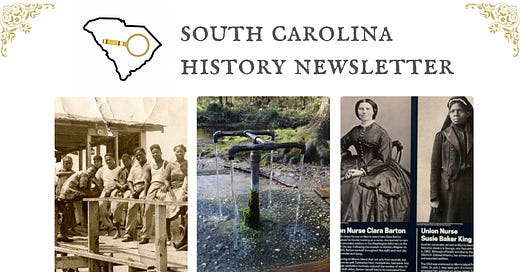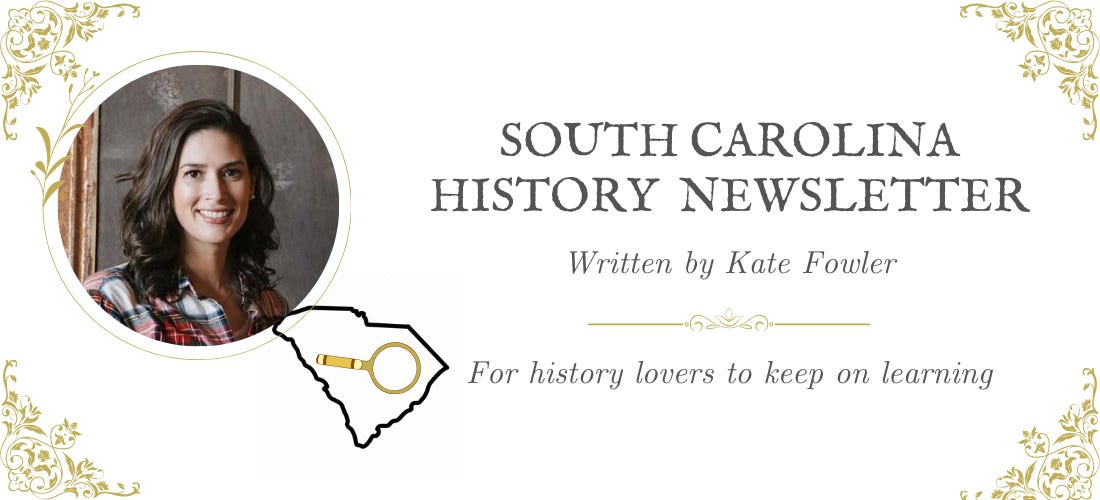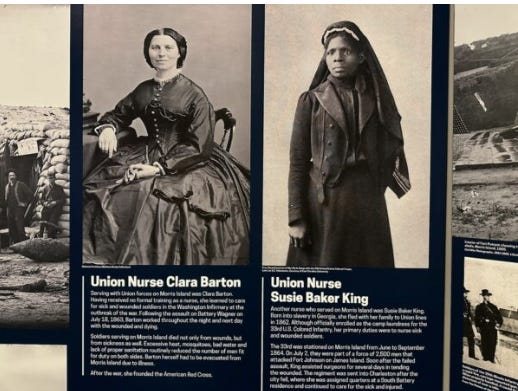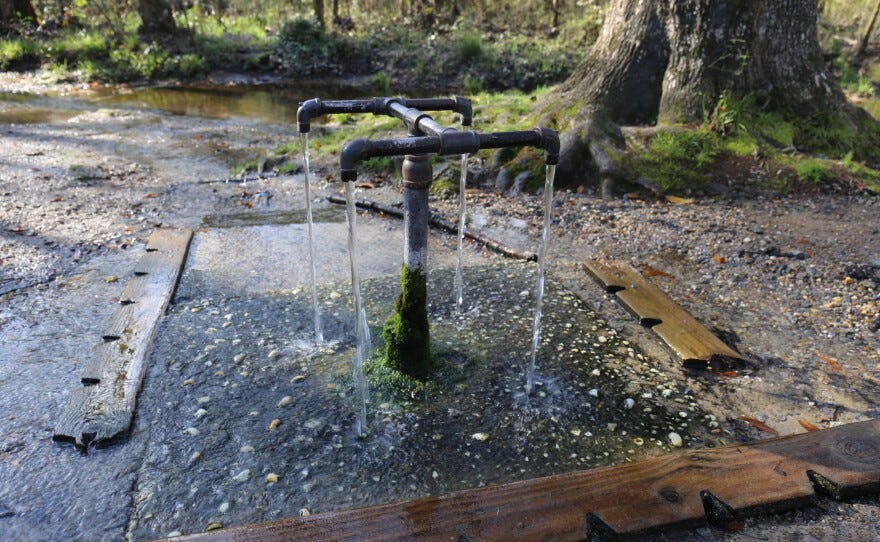#14: "Shaking a leg" in Mosquito Beach, healing waters in Blackville, and heroines of Charleston's past
For South Carolina history lovers far and wide! Enjoy weekly SC history and upcoming SC historical events
Dear reader,
Welcome to Newsletter #15 of The South Carolina History Newsletter! I’m so happy you’re here.
Welcome “aphoffman” “h.hemphill” “mc4chile” and “parrishm17” to our SC History Newsletter community! Woohoo!
I hope you enjoy today’s newsletter, and as always, please feel free to reply to this email with your ideas and suggestions on South Carolina history you’d like to learn more about. I’m only a click away.
Additionally, please join us & keep the conversation going by becoming a member of our SC History Newsletter Facebook Community here! I can’t wait to meet you.
And now, let’s learn some South Carolina history!
Yours truly,
Kate
(Writing from Greenville, SC)
3 ➳ Upcoming SC History Events
To celebrate Black History Month, each newsletter in February highlights one Black History focused event. The Black History events will be listed first below.
While I have curated the following 3 events below to feature in today’s newsletter, please click here to visit my SC History Events Calendar that organizes all the events I have featured in the newsletter to date, as well as others I have discovered. Please let me know if you’d like to add an event to the list! Reply to this email or send me a note at schistorynewsletter@gmail.com.
I.
BLACK HISTORY MONTH HIGHLIGHT: Tuesday, February 27th, 6:00 pm - 8:00 PM | “Soda City Series: Book Launch w/ Carolyn Pearson Jenkins for her book ‘Blazing to Freedom’” | All Good Books Bookstore | Columbia, SC | FREE and Open to the public
“Carolyn Pearson Jenkins will introduce her just-released book, Blazing Toward Freedom: Septima Poinsette Clark’s Story from Slave to Queen Mother of the Movement. From dehumanized slaves to second class citizens and to fighters for civil rights, Septima Poinsette Clark passionately tells this riveting story of her family’s lineage.
Jenkins was born and raised in South Carolina. She devoted 38 years to educating children and adults. She has received outstanding teacher and media specialist awards throughout the years. Because she is passionate about all learners having access to quality literature and curriculum options, she writes to fill the curriculum resource voids she feels exists in our schools. She is a former librarian, teacher, curriculum coordinator, and adjunct professor. Blazing Toward Freedom: Septima Poinsette Clark’s Story From Slave to Queen Mother of the Movement is her first book.
This event is being co-sponsored by the Center for Civil Rights History and Research at the University of South Carolina.”
II.
Tuesday, March 5th at 11:00 am | “Delices a l’orange - an experience with Chef Linda Gillette and Elizabeth Gray - Presented by Explore Charleston and Huguenot Society of South Carolina” | Charleston Visitor Center | Charleston, SC | FREE but reservations required
“We are thrilled to bring this unique culinary workshop with a touch of Huguenot history to our membership and the public. Reserve your seat today!”
III.
Friday, March 15th from 2:00 - 4:00 pm | “Workshop: Heroines of History” | The Charleston Museum | Charleston, SC | Tickets: $10 Museum Members, $15 Non-members
“Learn all about the women who shaped Charleston’s history and participate in activities representing their spirit. Embark on a guided tour of the Museum emphasizing women and their roles in Charleston’s past. Read letters from women who journeyed across the ocean to colonial Charleston, decorate a cutlass fit for a fearsome female pirate, learn to bandage wounds like nurses in the Civil War, and use dye first cultivated in Charleston by a young woman. Museum Workshops offer kids a chance to get hands-on with history and natural history. Included in our workshops are a lesson on the topic and hands-on activities. Recommended for children ages 6 to 12. Reservations required.”
2 ➳ SC History Fun Facts
I.
Did you know that there are healing waters in Blackville, South Carolina?
In what was once territory of the Edisto Native American tribe, and is now Blackville, South Carolina, there is a sacred spring where generations of visitors have come to fill up their water jugs with healing waters. Historical records dating back to the 1770s show that the Edistos believed the waters to be sacred and “a source of health and healing.” The legend grew even stronger during the American Revolution when 4 British soldiers were gravely injured in a nearby battle in Windy Creek. The men were left to die, but the Edisto tribe came upon them, and brought the soldiers to the healing spring, where they drank the waters and washed their wounds. Remarkably, the soldiers recovered and returned to their garrison in Charleston 6 months later to the astonishment of their fellow soldiers.
The land has changed hands through successive generations, and most recently was owned by a name named L.P. “Lute” Boylston, who on July 1st 1944 legally deeded “God’s Acre Healing Springs” to God, “permanently freeing the property from being taxed, also compelling the government to be responsible for its upkeep and water quality.”
Pipes have been installed to better allow visitors to fill up their water bottles. Visitors from all over the state travel to the springs to stock up on the healing water, which people drink, but also bathe in. Devotees of the healing waters swear that it has kept them healthy for many years.
Have any of our SC History Newsletter readers drank the healing waters of God’s Acre Healing Springs?
II.
Did you know that during the Jim Crow era of South Carolina history, the Black community created a thriving summer community called “Mosquito Beach”?
Mosquito Beach, aptly named for its year-round infestation of mosquitoes, was once the southern boundary of a 800-acre plantation owned by a man named Solomon Legare. After the Civil War, the land began a history of “African American ownership & entrepreneurship, from farming to an oyster factory, to a recreational destination for Lowcountry Black families.”
The post Civil War land owners were Black farmers Nelson Left, Edward Green, John Lafayette, and Harrison Wilder. As the years wore on, a Beaufort Oyster Merchant and Savannah-native named George Creighton Varn signed a lease with the descendants of farmer Nelson Left for 2 acres at the west end of today’s Mosquito Beach for the establishment of an oyster factory.
The oyster factory was an “unsavory business.” A reporter from the 1920s described the “smell that reeks to heaven.” Many poor families worked as “shuckers” at the oyster factory — but by the 1930s, the factory closed down. The land, however, was still known as “The Factory” and served as a “meeting place for the surrounding community.”
The heyday of Mosquito Beach arrived in the 1950s. Prior to the Civil Rights Act of 1964, “most entertainment and recreational venues in Charleston…prohibited black citizens” and the nearby beaches, including Folly Beach, were segregated. Because of this, and the opening of a store owned by local resident Joe Chavis, Mosquito Beach was one of a handful of Black beaches that became an exciting destination for the black community, a "refuge where people could swim, fish, and boat safely.” Additionally, there was a rich culture of music, dancing, and nightlife. Other nightlife establishments popped up on the beach, including the Harborview Club, Machi & Nucca’s pavilion, and Jack Walker’s Club.
Mosquito Beach was not just a destination for local James Island residents. Word of mouth was so strong and traveled so fast that people from downtown Charleston and across the southeast came to Mosquito Beach to enjoy themselves. Oral histories of the area share that Mosquito Beach was the place “to see and be seen,” that residents “strutted down the strip” to showcase their wardrobes, and that the island became “the dating scene” throughout the 1950s and 60s.
Once the weekends arrived, Mosquito Beach came alive with eating, drinking, and dancing. Local resident Edward Wilder remembers “dancing to blues music and doing the shag, traveling from one building to the next on the Mosquito Beach strip.” Joe Chavis was known “to often play the blues on a metal washboard with a fork and knife outside the Seaside Grill.”
Local resident Susan Chavis wrote in 2015 of Mosquito Beach during the early 1960s:
It was to give African Americans a place to enjoy themselves by ‘strutting’ up and down the area, catching a breeze, listening to a variety of music, shaking a leg, and buying some of the best soul and southern food, and just enjoying each other without the pressure of dividing lines."
1 ➳ Quote from an SC historical figure
I.
“They [the white visitors] were a little apprehensive as to how they going to get treated, but if you’re out to have a good time, you can have a good time no matter what color you are. There was no animosity.”
—William G. “Cubby” Wilder, remembering dances at Mosquito Beach, a historically black vacation spot
Sources used in today’s newsletter:
I always want to improve my work. Answer the poll below to give me your review of today’s newsletter. I also welcome your suggestions for new content! Simply reply to this email with your ideas. Thank you!


















